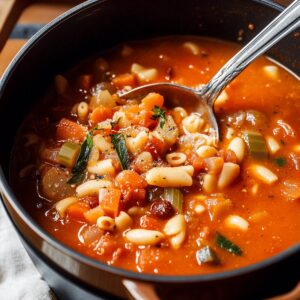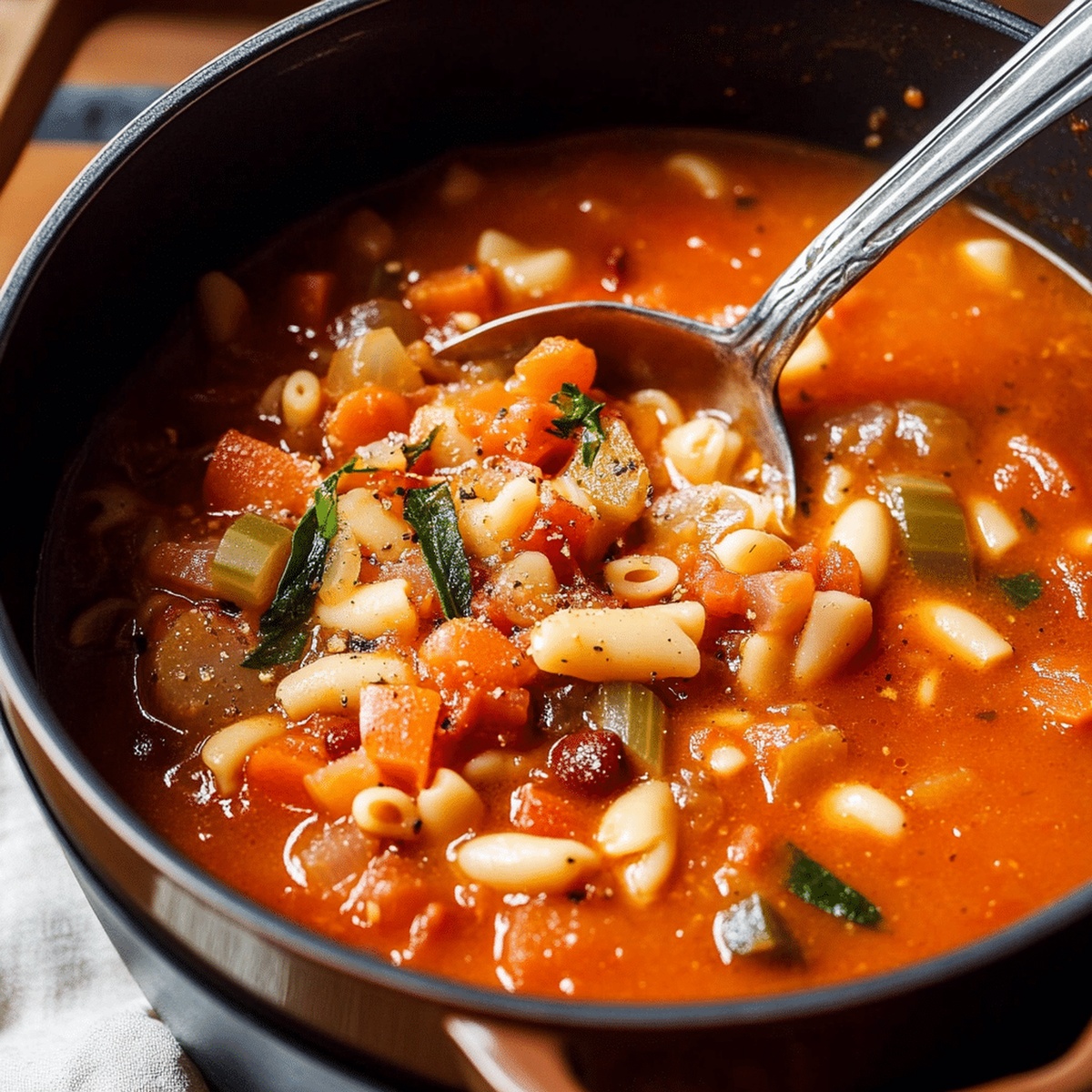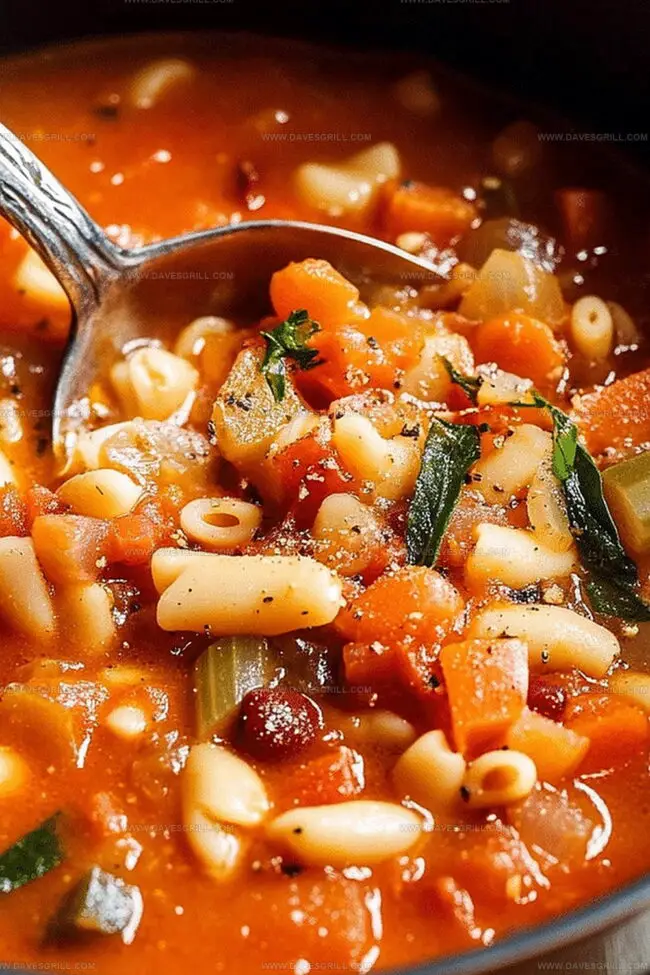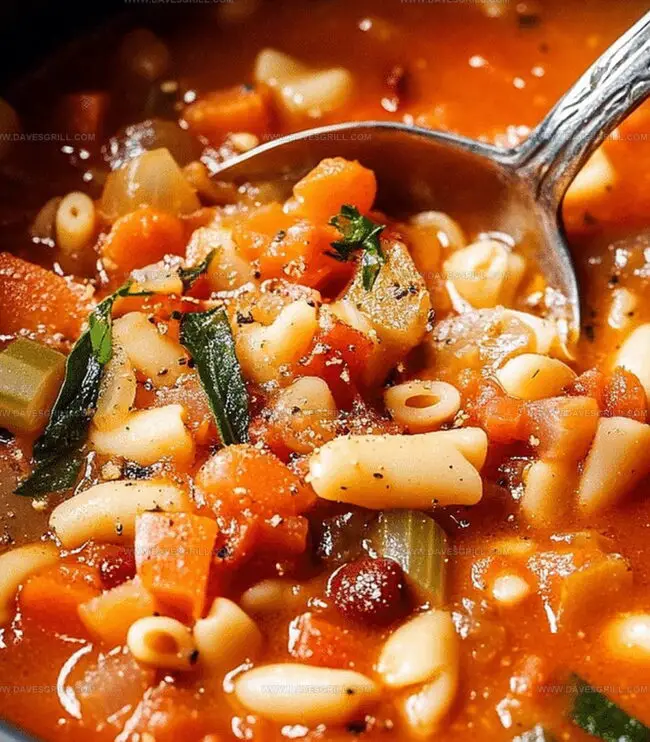Minestrone Soup Recipe to Adore
Comfort wraps around you like a warm minestrone soup on a chilly evening.
The Italian classic brings memories of rustic kitchens and hearty gatherings.
Vibrant vegetables dance through rich broth, creating a symphony of flavors that speak to generations of home cooking.
Beans and pasta intertwine, telling stories of simple, nourishing meals.
Fresh herbs whisper subtle notes of tradition across each spoonful.
Mediterranean sunshine seems to peek through this robust, satisfying dish.
Dive into a recipe that promises both nutrition and pure culinary joy.
Things to Highlight in Minestrone Soup
Ingredients You’ll Need for Minestrone
Base Vegetables:Aromatics and Herbs:Liquid and Protein Components:Finishing Touches:Steps to Make a Balanced Minestrone
Step 1: Kickstart the Flavor Base
Heat olive oil in a large pot over medium heat. Add:Cook for 5 minutes until vegetables soften. Toss in garlic and sizzle for 1 minute until aromatically rich.
Step 2: Build Vegetable Layers
Introduce:Sprinkle in oregano, basil, and red pepper flakes. Stir and cook for 2-3 minutes to release herb essences.
Step 3: Create Liquid Foundation
Pour into the pot:Bring mixture to a rolling boil, then lower heat to a gentle simmer. Let ingredients mingle for 10 minutes.
Step 4: Add Hearty Elements
Stir in:Simmer for 10-12 minutes until pasta reaches perfect tenderness.
Step 5: Enhance with Greens
Fold in chopped spinach or kale. Cook for 2-3 minutes until leaves wilt beautifully. Season with salt and pepper to taste.
Step 6: Serve with Love
Ladle into warm bowls. Sprinkle with fresh parsley and grated Parmesan cheese if desired. Enjoy your comforting soup creation!
Tips for a Cozy Pot of Minestrone
How to Keep Minestrone Soup Fresh
Best Pairings for Minestrone Meals
Options for Updating Minestrone Soup
Print
Minestrone Soup Recipe
- Total Time: 45 minutes
- Yield: 6 1x
Description
Hearty minestrone soup brings Italian countryside comfort to your kitchen, brimming with colorful vegetables and savory herbs. Nutritious ingredients and rich broth create a delightful meal you’ll savor with each warming spoonful.
Ingredients
Vegetables and Aromatics:
- 1 medium onion, diced
- 2 carrots, diced
- 2 celery stalks, diced
- 2 cloves garlic, minced
- 1 medium zucchini, diced
- 1 cup green beans, chopped
- 1 cup fresh spinach or kale, chopped
Proteins and Beans:
- 1 (14 ounces / 400 grams) can cannellini beans, rinsed and drained
- 1 (14 ounces / 400 grams) can diced tomatoes
Liquids, Grains, and Seasonings:
- 4 cups (960 milliliters) vegetable broth
- 1 cup (240 milliliters) water
- 2 tablespoons olive oil
- ½ cup (80 grams) small pasta (like ditalini or elbow macaroni)
- ½ cup (100 grams) rice or barley (optional, for added texture)
- 1 teaspoon dried oregano
- 1 teaspoon dried basil
- ½ teaspoon crushed red pepper flakes (optional, for heat)
- Salt and black pepper to taste
- 2 tablespoons fresh parsley, chopped
- Grated Parmesan cheese (optional, for garnish)
Instructions
- Warm olive oil in a spacious pot over moderate flame, introducing diced onions, carrots, and celery. Gently sauté for approximately 5 minutes until vegetables soften and release their aromatic essence.
- Incorporate minced garlic and continue cooking briefly, allowing the fragrance to permeate the kitchen. Introduce zucchini and green beans to the vegetable medley.
- Sprinkle oregano, basil, and red pepper flakes over the vegetables, stirring to distribute seasonings evenly and enhance their flavor profile.
- Pour vegetable broth, water, and diced tomatoes into the pot. Elevate heat to trigger a rolling boil, then immediately reduce to a gentle simmer.
- After 10 minutes of simmering, integrate pasta and cannellini beans. Continue cooking, allowing pasta to become tender and absorb the rich, herbaceous broth.
- Delicately fold chopped spinach or kale into the soup, letting the greens wilt and merge with the other ingredients. Taste and adjust seasoning with salt and pepper as needed.
- Ladle the vibrant, hearty soup into serving bowls. Optional: Garnish with fresh parsley and a sprinkle of Parmesan cheese for an additional layer of flavor and visual appeal.
Notes
- Boost vegetable flavor by roasting them before adding to the soup for deeper, caramelized notes that enhance overall taste profile.
- Customize the soup’s protein content by swapping cannellini beans with chickpeas, lentils, or adding diced chicken for more variety.
- Reduce sodium by using low-sodium vegetable broth and controlling salt levels during cooking, allowing individual seasoning preferences.
- Extend soup’s shelf life by storing vegetables and pasta separately, mixing only when reheating to maintain optimal texture and prevent soggy ingredients.
- Prep Time: 15 minutes
- Cook Time: 30 minutes
- Category: Lunch, Dinner, Appetizer
- Method: Simmering
- Cuisine: Italian
Nutrition
- Serving Size: 6
- Calories: 150
- Sugar: 4 g
- Sodium: 600 mg
- Fat: 5 g
- Saturated Fat: 1 g
- Unsaturated Fat: 3 g
- Trans Fat: 0 g
- Carbohydrates: 24 g
- Fiber: 6 g
- Protein: 6 g
- Cholesterol: 0 mg




Dave Mitchell
Founder & Chief Recipe Developer
Expertise
Education
Asheville-Buncombe Technical Community College
Associate of Applied Science in Culinary Arts
Focus: Comprehensive training in culinary techniques, kitchen management, and menu planning, with a special emphasis on grilling and outdoor cooking.
Dave Mitchell is the heart behind Daves Grill, a cook, writer, and lover of all things grilled. He studied Culinary Arts at Asheville-Buncombe Technical Community College and spent years cooking, testing, and sharing recipes that actually work.
Dave started Daves Grill to keep things simple: one great recipe at a time. His food is bold, easy to follow, and made for real people with regular kitchens. From juicy steaks to quick sides, Dave’s recipes bring the heat without the hassle.